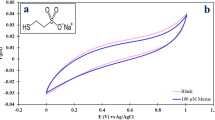Abstract
In this study, we have prepared the blending of gold nanoparticles-multiwalled nanotubes (Au-MCNTs) and then applied the new nanocomposites to modify the glassy carbon electrode (GCE) for highly sensitive detection of the interaction between anticancer drug daunorubicin (DNR) and cancer cells. Electrochemical analysis indicates that the Au-MCNT modified GCE shows high sensitivity and could track the real time response of cancer cells under DNR treatments. Therefore, this new nano-interface and Au-MCNT modified electrode could be explored as a rapid, highly sensitive, and convenient real-time detection strategy in cancer related research and would have prospect in other biomedical applications.
Similar content being viewed by others
References
Gewirtz DA. A critical evaluation of the mechanisms of action proposed for the antitumor effects of the anthracycline antibiotics adriamycin and DNR. Biochem Pharma, 1999, 579(7): 727–741
Fornari FA, Randolph JK, Yalowich JC, Ritke MK, Gewirtz DA. Interference by doxorubicin with DNA unwinding in MCF-7 breast tumor cells. Mol Pharmacol, 1994, 45(4): 649–656
Song M, Guo DD, Pan C, Jiang H, Chen C, Zhang RY, Gu ZZ, Wang XM. Application of poly(N-isopropylacrylamide)-co-polystyrene nanofibers as an additive agent to facilitate the cellular uptake of an anticancer drug. Nanotechnology, 2008, 19(2): 165102–165108
He F, Shen Q, Jiang H, Zhou J, Cheng J, Guo DD, Li QN, Wang XM, Fu DG, Chen BA. Rapid identification and high sensitive detection of cancer cells on the gold nanoparticle interface by combined contact angle and electrochemical measurements. Talanta, 2009, 77(3): 1009–1014
Shen Q, You SK, Park SG, Jiang H, Guo DD, Chen BA, Wang XM. Electrochemical biosensing for cancer cells based on CNT/TiO2 nanocomposites modified electrodes. Electroanalysis, 2008, 20(23): 2526–2530
Song M, Zhang RY, Dai YY, Gao F, Chi HM, Lv G, Chen BA, Wang XM. The in vitro inhibition of multidrug resistance by combined nanoparticulate titanium dioxide and UV irradiation. Biomaterials, 2006, 27(23): 4230–4238
Iijima S. Helical microtubules of graphitic carbon. Nature, 1991, 354(7): 56–58
Iijima S, Ichihashi T. Single shell carbon nanotubes of 1nm diameter. Nature, 1993, 363(6): 603–605
Sun YP, Fu K, Lin Y, Huang W. Functionalized carbon nanotubes: properties and applications. Acc Chem Res, 2002, 35(12): 1096–1104
Sinha N, Yeow JT. Carbon nanotubes for biomedical applications. IEEE T Nanobiosci, 2005, 4(2): 180–195
Popov VN. Carbon nanotubes: Properties and application. Mat Sci Eng R, 2004, 43(3): 61–102
Baughman RH, Zakhidov AA, Heer WA. Carbon nanotubes—the route toward applications. Science, 2002, 297(5582): 787–792
Jaur MF, Renier A, Daubriac J. Mesothelioma: Do asbestos and carbon nanotubes pose the same health risk? Part Fibre Toxicol, 2009, 6(1): 16–29
Foldvari M, Bagonluri M. Carbon nanotubes as functional excipients for nanomedicines: II. drug delivery and biocompatibility issues. Nanomedicine, 2008, 4(3): 183–200
Jia G, Wang HF, Yan L, Wang X, Pei RJ, Yan T, Zhao YL, Guo XB. Cytotoxicity of carbon nanomaterials: single-wall nanotube, multi-wall nanotube, and fullerene. Environ Sci Technol, 2005, 39(5): 1378–1383
Kostas K. The long and short of carbon nanotube toxicity. Nat Biotechnol, 2008, 26(7): 774–776
Gearheart LA, Ploehn HJ, Murphy CJ. Oligonucleotide adsorption to gold nanoparticles: A surface-enhanced Raman spectroscopy study of intrinsically bent DNA. J Phys Chem B, 2001, 105(50): 12609–12615
Zhang RY, Wang XM. One step synthesis of multiwalled carbon nanotube/gold nanocomposites for enhancing electrochemical response. Chem Mater, 2007, 19(5): 976–978
Li QN, Wang XM, Lu XH, Tian HE, Jiang H, Lv G, Guo DD, Wu CH, Chen BA. The incorporation of daunorubicin in cancer cells through the use of titanium dioxide whiskers. Biomaterials, 2009, 30(27): 4708–4715
Jiang H, Wang XM. Highly sensitive detection of daunorubicin based on carbon nanotubes-drug supramolecular interaction. Electrochem Commun, 2009, 11(1): 126–129
Author information
Authors and Affiliations
Corresponding author
Rights and permissions
About this article
Cite this article
Li, Q., Wu, X., Zhao, J. et al. Real-time detection of the interaction between anticancer drug daunorubicin and cancer cells by Au-MCNT nanocomposites modified electrodes. Sci. China Chem. 54, 812–815 (2011). https://doi.org/10.1007/s11426-010-4123-8
Received:
Accepted:
Published:
Issue Date:
DOI: https://doi.org/10.1007/s11426-010-4123-8




